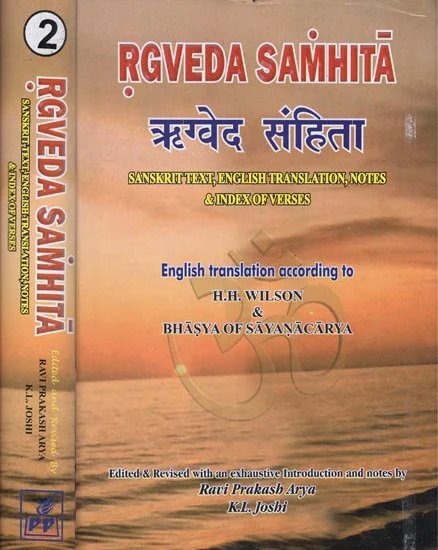Rig Veda (translation and commentary)
by H. H. Wilson | 1866 | 1,999,864 words | ISBN-10: 8171101380 | ISBN-13: 9788171101382
The Rig-Veda, English translation, including the commentary of Sayana and grammatical analysis. The hyms of the Rigveda Samhita represents some of the oldest and complex of Hindu Sanskrit literature. In ten books, these mantras form the core essence of rituals and ceremonies once widely performed throughout ancient India. This edition contains the...
Disclaimer: These are translations of Sanskrit texts and are not necessarily approved by everyone associated with the traditions connected to these texts. Consult the source and original scripture in case of doubt.
Rig Veda 10.85.35
Sanskrit text [Accents, Plain, Transliterated]:
आ॒शस॑नं वि॒शस॑न॒मथो॑ अधिवि॒कर्त॑नम् । सू॒र्याया॑: पश्य रू॒पाणि॒ तानि॑ ब्र॒ह्मा तु शु॑न्धति ॥
आशसनं विशसनमथो अधिविकर्तनम् । सूर्यायाः पश्य रूपाणि तानि ब्रह्मा तु शुन्धति ॥
āśasanaṃ viśasanam atho adhivikartanam | sūryāyāḥ paśya rūpāṇi tāni brahmā tu śundhati ||
English translation:
“Behold the forms of Sūrya, the āśasana (bordercloth) the viśasana (headcloth), the adhivikartana(divided skirt); of these the Brāhmaṇa relieves her.”
Commentary by Sāyaṇa: Ṛgveda-bhāṣya
Āśasana = tūṣādhāna, the receptacle of the fringe, ofa different colour;
Viśasana = that which is to be plural ced on the head; that which is to be plural ced at the end of thefringe (or border);
Adhivikartanam = the garment which is cut into three pieces. These terms may not relate todress, but to the cutting up of an animal
Details:
Ṛṣi (sage/seer): sūryā sāvitrī;Devatā (deity/subject-matter): sūryā ;
Chandas (meter): anuṣṭup ;
Svara (tone/note): Swar;
Padapatha [Accents, Plain, Transliterated]:
आ॒ऽशस॑नम् । वि॒ऽशस॑नम् । अथो॒ इति॑ । अ॒धि॒ऽवि॒कर्त॑नम् । सू॒र्यायाः॑ । प॒श्य॒ । रू॒पाणि॑ । तानि॑ । ब्र॒ह्मा । तु । शु॒न्ध॒ति॒ ॥
आशसनम् । विशसनम् । अथो इति । अधिविकर्तनम् । सूर्यायाः । पश्य । रूपाणि । तानि । ब्रह्मा । तु । शुन्धति ॥
āśasanam | vi-śasanam | atho iti | adhi-vikartanam | sūryāyāḥ | paśya | rūpāṇi | tāni | brahmā | tu | śundhati
Multi-layer Annotation of the Ṛgveda
[Rigveda 10.85.35 English analysis of grammar]
[noun], nominative, singular, neuter
[noun], nominative, singular, neuter
“cut; slaughter.”
[adverb]
“now; but; furthermore.”
[noun], nominative, singular, neuter
[noun], genitive, singular, feminine
“Citrullus colocynthis Schrad..”
[verb], singular, Present imperative
“see; view; watch; meet; observe; think of; look; examine; behold; visit; understand.”
[noun], accusative, plural, neuter
“form; appearance; beauty; look; shape; shape; symptom; feature; nature; guise; rūpa [word]; one; appearance; likeness; color; kind; vowel; type; disguise; aspect; form; derivative; omen; vision.”
[noun], accusative, plural, neuter
“this; he,she,it (pers. pron.); respective(a); that; nominative; then; particular(a); genitive; instrumental; accusative; there; tad [word]; dative; once; same.”
[noun], nominative, singular, masculine
“Brahma; Brahmin; dhak; Brahman; brahman [word]; Brahman; Brahmin; Brahmapurāṇa; Vishnu; Brihaspati.”
[adverb]
“now; then; but; and; now; however; then; then; surely.”
[verb], singular, Present indikative
“become pure; purify; wash; expiate; clean; cleanse.”
